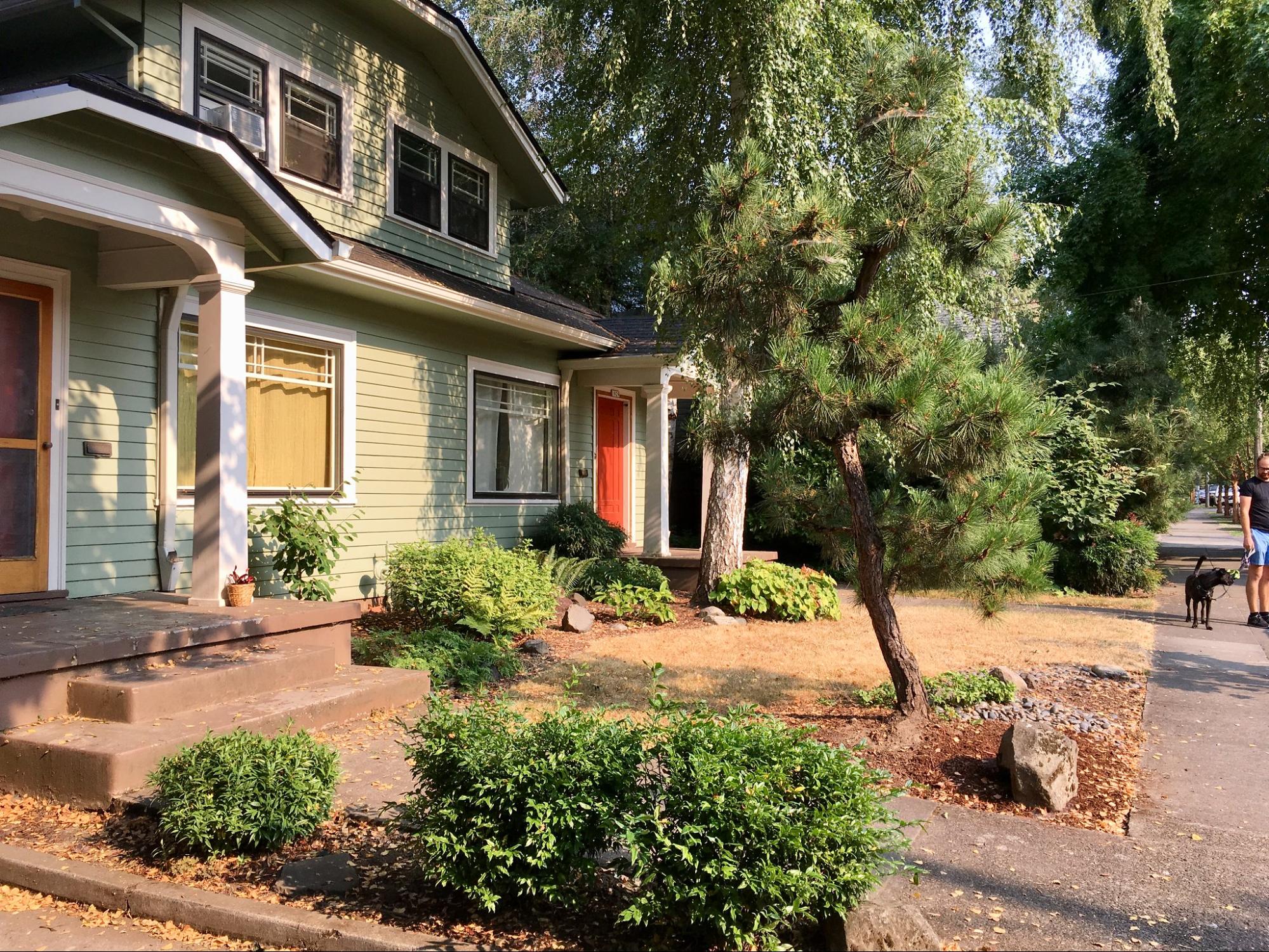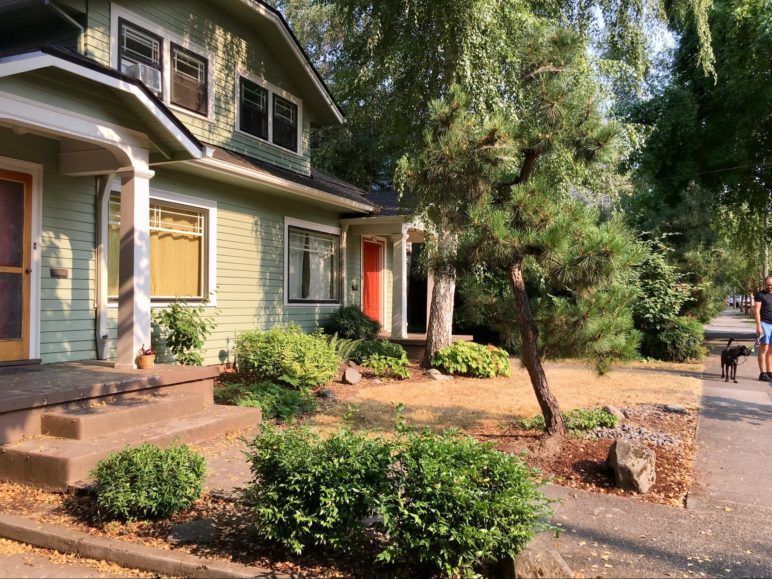Housing solutions had a good year. With some noticeable shifts in attitudes and conversations, 2019 marked a turning point. Even if the sun has yet to rise on a newly abundant urban housing market, the future looks bright.
There were outright wins too, including some of the biggest right here in Cascadia.

As Sightline research associate Nisma Gabobe wrote recently, abundant housing successes, especially those relegalizing granny flats, “in California, Oregon, Seattle, and many other Cascadian cities is part of a groundswell across North America to re-legalize homes of all shapes and sizes.” As she notes, these changes begin to “undo the classist and racist legacy of ‘single-family’ zoning.” And with that she sums up the kind of year 2019 turned out to be for abundant housing policy.
But there were outright wins too, including some of the biggest right here in Cascadia. This summer, Oregon lawmakers passed a groundbreaking middle housing bill (HB 2001), re-legalizing fourplexes in all large cities and duplexes almost everywhere in the state. The City of Seattle updated its ADU policy this year, enacting the most progressive cottage regulations of any major US city. We also cheered wins for more homes of all shapes and sizes in Tacoma, Washington. Vancouver’s new city council, for all its failures, turned out to be more pro-housing than we might have guessed. And Cascadian housing advocates watched eagerly as Minneapolis and California reset their rules to allow more homes too.
These ideas are clearly contagious. Just days ago, Virginia legislators introduced statewide duplex and cottage legalization bills modeled on Oregon’s.
Even though other affordability proposals didn’t triumph, like Washington State’s first run at true state-wide ADU legislation, the ways people are talking about housing policy are shifting, setting the stage for progress on solutions in the coming year. From the US presidential primary candidates to the United Nations to climate leaders like Bill McKibben and unlikely bipartisan alliances and progressive stars like Alexandria Ocasio-Cortez, people with a platform are including upzoning as part of a strategy for equitable sustainability. As CityLab’s Sarah Holder and Kriston Capps put it: “Cities are gaining political traction for policies that once seemed out of the question. The newest tool that cities are deploying in the ongoing fight against segregation and housing inequality is to let their streets get denser, in what is known as upzoning.” But they give us a reality check, too: “Making zoning more progressive still faces awfully long odds, though, which makes this strategy a question of policy and politics.”
We also saw a surge of coverage of housing affordability solutions in the press—and Sightline’s researchers talked to a lot of reporters. Looking back on the year, we thought we’d highlight our favorite media moments and voices:
Seattle Times, Opinion: Loosen backyard-cottage rules to create greener, fairer Seattle
Take this op-ed penned by three Seattle powerhouses: Seattle city councilor Teresa Mosqueda, 350 Seattle’s Emily Johnston, and Alex Brennan, then of Capitol Hill Housing, now executive director of Futurewise. They make the case that by “loosening rules for backyard cottages, granny flats and garage apartments, Seattle will advance equitable access to housing and move closer to its climate goals.” Their voices were a welcome balm given the wounds inflicted on affordability policy (and city leaders who champion it) by the Times’ own editorial board’s anti-density bent.
New York Times: How developers became such a ‘dirty’ word
We’re not the only ones who noticed the Seattle Times’ stance. Emily Badger, covering the New York Times’ urban policy beat, wrote, “when The Seattle Times’s editorial board warned of developers ‘gorging’ on the city, it was opposing regulations making it easier to build … modest options.” The paradox is paralyzing. She writes, “the kind of development that prompts some of the loudest outcry—triplexes in Minneapolis, backyard cottages in Seattle, “missing middle” housing in Portland—has the best chance of being relatively more affordable, for the builder and the resident.” In any city with a housing shortage, she points out, “the villain blamed for the problem, in other words, must be part of solving it.” We were proud to see Badger link to Sightline research for this piece.
New York Times: Cities start to question an American ideal: A house with a yard on every lot
It wasn’t the only time Badger referenced our work. In June, she teamed up with Quoctrung Bui to challenge the gospel of single-detached zoning. “Today the effect of single-family zoning is far-reaching,” they point out, “It is illegal on 75 percent of the residential land in many American cities to build anything other than a detached single-family home.” They point to the case made by housing affordability reformers that a “reckoning with single-family zoning is necessary amid mounting crises over housing affordability, racial inequality and climate change.” The authors take a close look at cities around the country (with interactive maps), including Portland, Oregon, and Seattle, where they point to senior researcher Dan Bertolet’s number crunching.
Vox: America has a housing segregation problem. Seattle may just have the solution
Zip code is destiny, many studies tell us. “Living in certain neighborhoods seems to expand opportunity, and living in other neighborhoods seems to diminish it.” But low-income people don’t necessarily move to more opportunity, even if they could swing it. In 2019, a Seattle experiment combined Section 8 vouchers with information and support for recipients about moving to neighborhoods that promised the most opportunity for their kids. The simple intervention yielded significant successes. Economist Raj Chetty and fellow researchers, Nathaniel Hendren, Larry Katz, Stefanie DeLuca, Peter Bergman, and Christopher Palmer—and in collaboration with the Seattle Housing Authority and the King County Housing Authority, saw the share of families moving to high-opportunity neighborhoods from 14 percent to 54 percent. Vox’s Dylan Matthews wrote, “If it can be replicated at scale, the experimenters may have hit on a powerful new tool for dismantling residential segregation in the United States.” Vox’s story references Margaret Morales’ research on zoning reform as one powerful tool to reverse school segregation.
Los Angeles Times: Oregon vowed not to become California—and passed sweeping housing crisis legislation
You know the tides have turned for Cascadian housing politics when Liam Dillon of the Los Angeles Times holds up Oregon’s missing middle solution (a measure to avoid becoming more like California) as a lesson for Californians! (California’s SB50 fared better than SB827 before it.) “In Portland, we’re just trying not to become San Francisco,” Oregon House Speaker Tina Kotek told him. She steered to victory “the most ambitious response to housing affordability challenges in the country,” making Oregon the only state to eliminate single-family-only zoning in many of its residential neighborhoods. In Oregon, advocates representing renters and low-income residents like Pamela Phan stood beside YIMBYs and climate change groups to push for upzones. “We know that single-family zoning is exclusive,” Phan said. “Folks who have gained generational wealth from single-family homes in this country are by and large white people. That was by design.” Oregon leaders have charted a course for other states to follow.
Slate: Legalize it
Our housing team, and particularly those in Oregon, worked tirelessly behind the scenes to usher Oregon’s missing middle bill to victory and to share lessons for passing state-wide zoning reform. Slate’s Henry Grabar wrote, “at Sightline, Michael Andersen runs down the diverse coalition of interests lined up behind the law, underscoring how many different constituencies have come around to the need for zoning reform,” quoting whole cloth:
AARP of Oregon, which said middle housing makes it easier to age in place; The Street Trust, a transportation group that argued HB 2001 would let more people live near good transit and walkable neighborhoods; 1000 Friends of Oregon, which said the law would advance the state’s long fight against exclusionary zoning; Pablo Alvarez of Lane County NAACP, who said the bill would start to undo some of the ways racism has undermined housing affordability for all; Sunrise PDX, which called energy-efficient housing an essential way to fight climate change; and Portland Public Schools, which described the bill as a long-term way to reduce school segregation.
Register Guard, Opinion: Reforming our exclusionary past
And that brings us back to where this list started: with the voices that rang truest and loudest in these policy debates. Leaders like Pablo Alvarez spoke up for their communities and helped bring elected leaders together around affordable, sustainable zoning solutions in Oregon. Alvarez pointed out that many of our zoning and land use laws were originally designed to help keep people of color and poorer people away from areas of wealth and power. And he connected zoning solutions for racial and wealth equity in our cities, to climate and environmental values as well: “As the Environmental and Climate Justice organizer for the Lane County NAACP, I often find myself explaining to upper-middle class (generally white) folks what it means to move toward an environmentally just community: A community that values our natural resources for their intrinsic rather than economic value. A community that, regardless of race, gender, income, sexual preference or physical and mental ability, protects our land, water and air and safeguards our health and quality of life.”
We turned a corner in 2019. We’ll still face familiar foul weather for housing affordability policies, but the wind is blowing our way right now. So it’s time for climate hawks and housing-justice advocates to unfurl all their sails.
If Oregon is any guide, we’ll certainly need all hands on deck.












Ethan Seltzer
Thanks for your coverage of this issue. But please: don’t get too complacent. Note that with every ADU and every small addition of new housing to old zones, we create new landlords. And both Oregon and the City of Portland are passing new tenant’s rights legislation that make it both risky and expensive for small landowners to choose to become small landlords. The obvious impact is that rents will go up to ameliorate the risk, and that landlords will become bigger. Perhaps small landlords are the problem….I really don’t know. But I am impressed by how oblivious elected officials seem to be to the impacts of their moves to regulate landlords on their moves to generate more housing. Certainly tenants need rights, particularly in this economy. But no one appears to be connecting the dots between efforts to generate new units in existing neighborhoods and the real need to generate new landlords.
RDPence
Good comment, Ethan. For several years, I was a one-property landlord in Seattle, fortunately before all the restrictions and requirements began coming from City Hall. City Council needs to wise up and exempt the remaining small mom-and-pop landlords before they all go away.
BK
Thanks to all of you at Sightline for all your contributions toward progress on housing justice & affordability in 2019!
JimK
This is just following the latest fashion while ignoring the root cause: a shortage of land that is legal to build on. That shortage, like all shortages, drives up the price. In most places the shortage is caused by some form of growth boundary. GMA in Washington, UGB in Oregon and, in California, a lengthy legal processes to build on land outside of a city.
Cities without such controls, generally in the Midwest & South still have affordable housing. Some are growing faster than Oregon & have higher incomes, so the often heard excuse of nobody wants to live there is not true.
Finally, can anyone name a city that has made housing more affordable by increasing density?
BK
“Finally, can anyone name a city that has made housing more affordable by increasing density?”
Median household income in Manhattan is less than median household income in Seattle. So there are more households making less than Seattle’s median income living in proximity to Manhattan’s transit, schools, cultural amenities, services and jobs than there are households in all of Seattle.
Erik Kengaard
@ JimK – shortage of land or abundance of population?